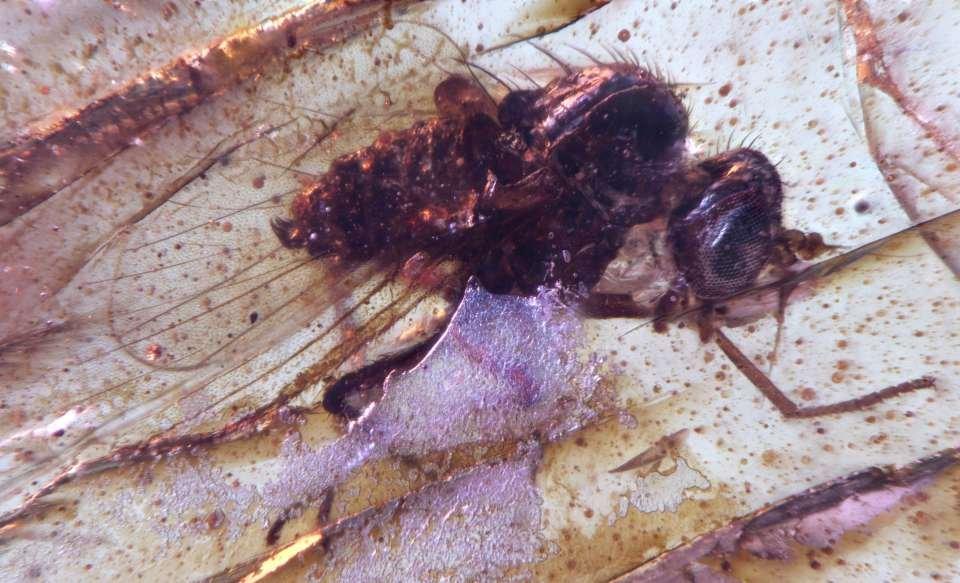Amber is of particular value to science. Tiny organisms or structures such as insects, spiders, spores, or pollen, which are otherwise rarely encountered in the fossil record, can be preserved three-dimensionally and almost undamaged in the petrified tree resin. “From the Cretaceous period, such ‘bio-inclusions’ are almost exclusively known from sites in the northern hemisphere. Our understanding of the biodiversity and ecosystems of the southern hemisphere during the period from 143.1 to 66 million years ago, when today’s continents began to separate from the supercontinent Gondwana, is very limited,” explains Dr. Mónica Solórzano-Kraemer from the Senckenberg Research Institute and Natural History Museum Frankfurt.
Together with the study’s leader, Dr. Xavier Delclòs from the University of Barcelona, and additional researchers from Spain, Panama, Colombia, Ecuador, Sweden, and the USA, the amber researcher examined material from the Genoveva quarry in the Ecuadorian province of Napo. The amber found there was dated to around 112 million years ago and belongs to a recently discovered deposit in the Hollín Formation, a sedimentary rock layer that extends across the Oriente Basin in Ecuador. “There are two different forms of amber there: Amber that formed underground around the roots of resin-producing plants, and amber formed by the hardening of resin in the open air,” adds Solórzano-Kraemer.
In around 60 “open-air amber” samples, the research team detected a total of 21 bio-inclusions, among them one representative of springtails and six insect orders. Dipterans are most frequently found in the ambers examined, including non-biting and biting midges, whose modern relatives also include blood-sucking species. Other inclusions represent beetles and Hymenoptera, including species that are now extinct and parasitoid ichneumon flies, as well as a caddisfly. The ensemble is completed by two representatives of the true bugs, including a whitefly. At the same time, numerous plant fossils such as spores and pollen were found in the sediment. Geochemical analyses carried out by the researchers point to evergreen, araucaria-like trees as a source of resin.
“Our findings suggest humid conditions or freshwater habitats such as ponds in the forest at that time. We assume that 112 million years ago, a humid, densely forested habitat existed in Equatorial Gondwana, which was already characterized by flowering plants,” says Solórzano-Kraemer, summarizing the results.
One particularly noteworthy find is a fragment of a spider web with several parallel threads running at right angles, which reveals the blueprint of a classic orb web. “The newly discovered amber deposit is of crucial importance for paleontology. It not only provides direct evidence of a forest ecosystem rich in resin, but also of its diverse arthropod fauna in the early Cretaceous period. The ambers and their inclusions allow us to open a ‘time capsule’ to explore the biodiversity and ecosystems of the southern hemisphere 112 million years ago,” summarizes the researcher from Frankfurt.
Senckenberg – Leibniz Institution for Biodiversity and Earth System Research // Senckenberg Gesellschaft für Naturforschung
Senckenberganlage 25
60325 Frankfurt
Telefon: +49 (69) 7542-0
Telefax: +49 (69) 746238
http://www.senckenberg.de
Senckenberg Forschungsinstitut und Naturmuseum Frankfur
Telefon: +49 (69) 7542-1127
E-Mail: Monica.Solorzano-Kraemer@senckenberg.de
Universität Barcelona
Telefon: +34 (93) 4021381
E-Mail: xdelclos@ub.edu
Leitung Pressestelle & Social Media
Telefon: 06975421434
E-Mail: judith.joerdens@senckenberg.de
![]()
